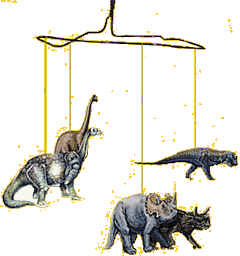

Dinosaur
Mobile
 Artists
think about balance when they make art. Sculptors have to worry about
whether their art will stand up or fall over! Some sculptors, like
John Payne, make sculptures that moveócalled
ìmobiles.î It can be very tricky to make everything
balance so it moves just right.
Artists
think about balance when they make art. Sculptors have to worry about
whether their art will stand up or fall over! Some sculptors, like
John Payne, make sculptures that moveócalled
ìmobiles.î It can be very tricky to make everything
balance so it moves just right.
Try your hand at making a dinosaur mobile!
You will need:
1. Print out 3-5 dinosaurs you like from the dinosaur patterns. You can choose dinosaur coloring outlines, and color them yourself, or print out the colored dinosaurs. Either way, try to select ones that are roughly the same size in real life (a T. Rex is much bigger than a tiny Compsagnathus) You might want to select a certain kind of dinosaur, such as carnivores or herbivores, large or small dinosaurs, etc.
2. If you printed the dinosaur outlines, color them now. If you printed the pre-colored dinosaurs, continue to Step 3.
3. Glue each dinosaur to a piece of cardboard.
4. Cut out each dinosaur from the cardboard. It¹s okay to cut around the dinosaur. Don¹t worry about getting it exact!
5. Find the balancing point for each dinosaur. Lightly hold each dinosaur by its top between your fingers. At the balancing point, the dinosaur should not tilt backwards or forwards, but balance just right.
6. Make a mark at the balancing point, then punch a hole there with a needle or pin. Put a piece of string through the hole.
7. Tie the string. Check again how the dinosaur balances, then repeat steps 4 and 5 for each dinosaur.
8. Bend a coat hanger to make a shape to hang your dinosaurs. Ask an adult to help you!

9. Hang the coat hanger where it can move freely (or have someone hold it). Tie your dinosaurs to the hanger.
10. Tie your dinosaurs to the hanger. Slide each dinosaur around until the entire mobile is balanced.
11. When you like how it looks, put drop of glue where the strings are tied to the coat hanger. Let the glue dry and hang your mobile!
Dinosaur patterns
Coloring
outlines:
Allosaurus,
Ankylosaurus,
Apatosaurus,Camarasaurus,
Camptosaurus,
Centrosaurus,
Chasmosaurus,
Compsognathus,
Hadrosaurid,Lambeosaurus,
Nodosaurus,
Parasaurolophus,
Pachycephalosaurus,
Plateosaurus,
Protoceratops,
Scutellosaurus,
Stegosaurus,
Struthiomimus,
Triceratops,
Tyrannosaurus
rex
Pre-colored
dinosaurs:
Allosaurus,
Ankylosaurus,
Apatosaurus,
Camarasaurus,
Camptosaurus,
Centrosaurus,
Chasmosaurus,
Compsognathus,
Hadrosaurid,
Iguandoon,
Lambeosaurus,
Nodosaurus,
Parasaurolophus,
Pachycephalosaurus,
Plateosaurus,
Protoceratops,
Pteranodon,
Scutellosaurus,
Stegosaurus,
Struthiomimus,
Triceratops,
Tyrannosaurus
rex,
Velociraptor.
![]()
Kinetosaurs Home Page
Copyright 1999 The Children's Museum of Indianapolis